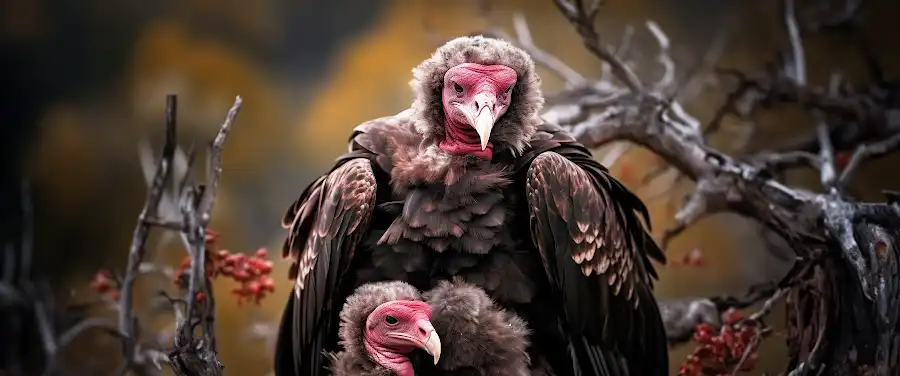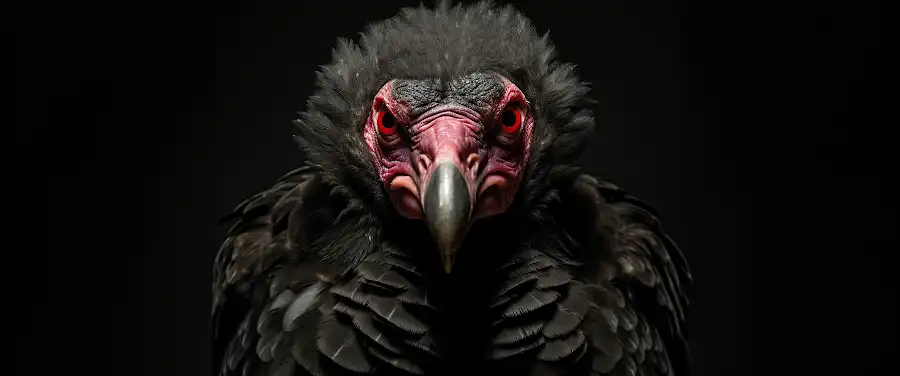
Imagine soaring through the open sky, riding on thermals, no engine noise, just the whispering wind as your flight soundtrack. Welcome to the world of the turkey vulture, buzzards nature’s efficient cleaner known for scavenging efforts that keep our environment healthy. Yet, there’s a lot more to these creatures than just their clean-up crew reputation. To truly appreciate the role they play, it’s vital to explore the intriguing cycle of their life and their fascinating breeding practices.
Turkey vultures have uniquely mastered the art of survival, displaying a life pattern that seamlessly intertwines with nature. Their life stages, from their tender nestling days to their adventurous adult life, is a tapestry woven with tales of survival, adaptability, and ecological significance. Equally captivating is their breeding cycle, where the norms of territoriality blur, as these vultures transform to doting parents, meticulously tending to their offspring’s needs, which is a far cry from the common perception tied to their ominous appearance.
By unraveling the complexity of the turkey vultures’ life cycle and breeding secrets, not only do we gain a deeper respect for them but we also shed light on their integral role in maintaining eco-balance. Each phase of their life, each breeding pattern holds the promise of a captivating story that challenges preconceived notions, encouraging us to see the beauty in the gritty realities of nature’s delicate web. But first things first, you might be wondering, “What exactly is a Turkey Vulture?” Let’s dive into it.
What is the Life Cycle of a Turkey Vulture?

The life of a Turkey Vulture unfolds in four remarkable stages — from an egg to a fully-fledged adult. These stages are the cornerstone of the life cycle of a turkey vulture. Let’s delve into the mesmerizing life journey of these magnificent beings!
The Four Stages
- 1Egg: The journey begins when a perfectly round egg is laid by a mature Turkey vulture. It’s quite an important event!
- 2Nestling: After about 40 days of incubation, the egg hatches, and an adorable, fuzzy nestling peeps outside.
- 3Juvenile: Around ten weeks later, the nestling morphs into a juvenile, ready to explore the world with its newfound wings.
- 4Adult: Over the next 5 years, the juvenile matures into an adult, exhibiting its characteristic red head and sharp beak.
The typical lifespan of a Turkey vulture is surprisingly long, with many living up to 20 years in the wild. This lengthy life span is largely due to their highly effective scavenging habits and scarcity of natural predators.
Growing, Changing, Maturing
As a turkey vulture grows older, it undergoes several noticeable age-related changes. For example, young vultures are darker in color than adults and their heads are covered in downy feathers. It’s only with maturity, that the vulture’s head becomes naked and turns a vivid red, earning them their distinguished, adult look.
How Do Turkey Vultures Grow and Develop During Each Stage?
Each stage in the turkey vulture’s life paints a captivating tale of survival and adaptation.
In the egg incubation stage, the parent’s attentiveness plays a pivotal role in ensuring the survival of the unhatched vulture. During this period, which typically lasts 38-41 days, the parents take turns to incubate and protect the eggs from predators.
As a nestling and juvenile, a turkey vulture experiences staggering physical development. During these formative stages, it practices flying, learns to identify edible carrion, and masters the scavenging skills crucial for its survival.
Upon reaching adult maturity, turkey vultures boast a wingspan up to 6 feet, a distinct red head, and a keen sense of smell. They now bear all the characteristics of a fully-grown, mature turkey vulture, armed with survival skills honed over the years.
Now that we’ve explored the life cycle of a turkey vulture, we’re well-equipped to delve into the intriguing nuances of turkey vulture breeding habits. Intrigued? Let’s delve further!
What are the Breeding Habits of Turkey Vultures?
When we think of rodents, we often picture minor nuisances. But the truth is, these tiny critters can create a ton of damage to your home, and in more ways than you might i
If you’ve ever been curious about the life cycle of the Turkey Vulture (Cathartes aura), you’re in for a treat. These creatures have unique breeding habits that are quite fascinating. Rather than using vocal calls, Turkey Vultures use a series of visual displays for mate selection, and they follow a strict bonding ritual.
When it comes to the mating season, Turkey Vultures are monogamous creatures. The breeding season typically begins around March. And don’t be fooled by their less-than-appealing appearance; their courtship displays are quite the spectacle, involving impressive aerial stunts with their future partners.magine.
How Do Turkey Vultures Prepare for Breeding?
But it’s not all about the courting rituals. The intense preparation for breeding, which includes nest building and breeding site selection, is a crucial part of the life cycle of a Turkey Vulture. Both sexes work together when preparing their nests, demonstrating a level of cooperation that’s truly admirable.
When it comes to breeding site selection, Turkey Vultures prefer remote areas like rock ledges, caves, and even hollow trees. This preference for hard-to-reach places keeps their offspring safe from predators.
What’s the Reproduction Process?
After the successful preparations come the actual reproduction process. Female Turkey Vultures typically lay two eggs which both parents will incubate for around 40 days. This dual responsibility is repeated in the offspring care, with both parents taking turns feeding and protecting their young ones through the regurgitation of their meals.
Turkey vultures’ chicks evolve into fledglings after nine to ten weeks of intense care. Their fledgling phase is critical to their survival, with parent vultures often closely supervising their first flights. Unfortunately, according to stats from the Cornell Lab of Ornithology, survival rate for fledglings is only around 30%. This high mortality rate is attributed to different factors including predation, starvation, and the perils of learning to fly.
It’s a vulture-eat-vulture world out there, and Turkey Vultures adhere to these rules. Their breeding and life cycle patterns are a testament to the harsh realities of wildlife. However, these birds do their share in maintaining the balance in our ecosystem, turning death into life in their own unique way.
It is important, however, to understand that the life cycle and breeding habits of Turkey vultures are impacted not just by predators and natural conditions but also by human activities.
Conclusion
In conclusion, the fantastic world of the Turkey vulture is as complex as it is intriguing. These impressive birds lead a life cyclical in nature, marked by stages of growth and reproduction, revealing a surprisingly structured breeding pattern. From their slightly dramatic courtship rituals to nesting and eventual chick rearing, the life of a Turkey vulture is no doubt the feathered tale of a survivor.
But why should we care about preserving Turkey vultures? After all, they’re just large birds that eat carrion, right? Well, not quite. Beyond their macabre dietary preference, Turkey vultures play a key role in our ecosystem. They are nature’s cleanup crew, eliminating rotted carcasses and diseases that could potentially impact other wildlife and even humans.
Just like bees to flowers, and worms to soil, Turkey vultures serve a vital purpose, making our world a healthier place. Their significant role therefore demands our attention and respect. We can show this by educating ourselves and others about their lives, including their distinct breeding patterns, and the steps we can take to help protect and preserve their existence.
True, it may be a bit unsettling to appreciate a creature that spends its day rummaging through remains. Yet, understanding and acknowledging their ecological role helps to emphasize how interconnected life on this planet truly is. From the smallest ant to majestic Turkey vultures, every creature has a contribution to make.
This understanding of the Turkey vultures’ life, behavior, and breeding can also spur us to play our part in the conservation efforts. So, next time you see one of these foreboding birds soaring high above, remember, they are not the ominous harbingers of death they are often perceived as but are instead our partners in maintaining environmental health. Remember, just as you play a part in the ecosystem, so too do our winged friends, the Turkey vultures.
Now, let’s all take a moment to appreciate the beauty and complexity of these creatures. Let’s work together to ensure the survival of the Turkey vultures for generations to come! They need us, just as much as we need them. Let’s do our part!




